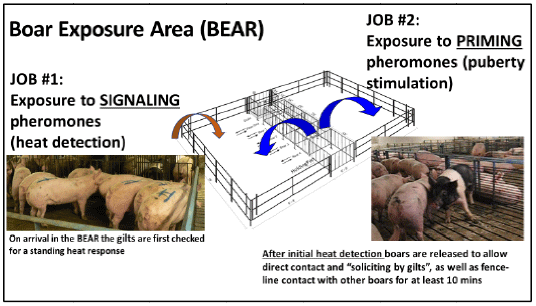Introduction
In a recent detailed review of the factors determining reproductive development in the gilt (Patterson and Foxcroft, 2019), we suggested that “Substantial evidence supports successful management of gilts as an absolutely necessary component of breeding herd management and the pivotal starting point for the future fertility and longevity of the breeding herd”. We also discussed the link between earlier sexual maturation and improved sow lifetime productivity (SLP). A comprehensive gilt management program will address several key factors that pre-determine SLP, including: Birth traits that determine the efficiency of replacement gilt production; effective selection of the most fertile gilts for entry to the breeding herd; programs that provide a consistent supply of service eligible gilts; and appropriate management of weight, physiological maturity, and a positive metabolic state at breeding. Good gilt management can largely resolve the existing gap between excellent genetic potential and the more modest sow lifetime productivity typically achieved in the industry.
The purpose of this presentation is not to repeat the detailed information presented in our recent review, nor to discuss the detailed physiological mechanisms involved. Rather, we will identify the key components of a good gilt management program in commercial practice and the excellent SLP that can result from applying such programs successfully. We will then look at two key factors that determine the timing of the final gilt selection program. Firstly, the age at which puberty is triggered in gilts and the positive relationship between earlier puberty and SLP. Secondly, data on the growth performance of contemporary gilt populations, highlighting the risk that high growth performance represents for gilt being too heavy at breeding. Next, we will briefly highlight the importance of pre-breeding management in the gilt and the need to create a gilt management program that allows the majority of gilts to be bred at second estrus. By routinely implementing a Heat-No-Serve (HNS) strategy producers can improve first parity performance in gilts, which itself seems to be predictive of SLP. Finally, we will identify those measures of gilt performance for which records are considered to be “non-negotiable” and describe how these records can be used to monitor gilt performance and compliance with established protocols.
Although many other factors can affect the performance of the breeding herd, data-based evidence that an effective gilt replacement program is in place will already allow production systems to meet existing industry benchmarks for excellent SLP.
Key components of an effective gilt selection program
In subsequent sections of this review, we will discuss the key factors that determine the actual timing of the final gilt selection program. However, from the outset, we wish to establish the benchmarks against which alternative strategies should be measured. In our minds, the exposure of immature gilts to the full spectrum of puberty-inducing boar stimuli continues to be the most effective way of identifying pubertal estrus. A HNS record is the only acceptable way of identifying a “select” gilt and a fully integrated puberty induction program as shown in Figure 1 is the only effective way of recording a HNS event in the 80% of select gilts that can also be bred before 230 days of age.
As shown in Figure 1, this system involves a purpose designed boar stimulation area (BEAR) that allows for: 1) excellent detection of a standing heat in response to signaling pheromones from a team of boars using initial fence-line contact. The record of a HNS event can be simply linked to a weight using either scales or other simpler but reliable measures of weight, like a weight-tape. Gilts are then provided direct contact with a rotation of mature, high libido, boars by releasing one of the available boars into the group of gilts. A minimum of 10 minutes of direct contact, with a gilt:boar ratio of not more than 12:1 in an appropriately sized pen, allows the gilts access to the primer pheromones secreted in the salivary “froth” of the boar. Stockmen frequently fail to realize that the gilt is driving the program here and during the pro-estrous period gilts will actively and aggressively “solicit” access to the boar’s salivary secretions. During this same period of direct boar contact, other boars are also providing a priming function through fenceline contact with the gilts in the group.
In our experience, the use of such BEAR facilities allows the detection of a naturally (boar) induced pubertal estrus in up to 80% of the gilt population within a 30-day final selection program. As discussed later, if a lower percentage of gilts than expected have a HNS event by day 23 of the program, intervention with exogenous gonadotropin treatment is used to elicit a hormonally induced estrus, as required to meet gilt breeding targets. Both the need to identify the most sexually mature gilts in the population, linked to the problems of older and overweight gilts being presented for breeding if the stimulation period is extended, determines that the BEAR system is essentially run as an all-in/all-out facility. Any gilt not in heat by day 30 is designated as non-select and shipped to market, vacating the space needed for the intake of pre-select gilts to the GDU.
Our belief in the value of this rigorous program of gilt selection is based on evidence of the excellent lifetime performance of the gilts delivered to the breeding program, accepting that the timing of the selection process allows for all gilts to be bred at least at second estrus. Figure 2 shows the results of a study carried out in collaboration with a commercial production system in North America, in which 288 gilts were entered every four weeks into an off-site gilt development unit (GDU) with duplicated BEARs facilities, that allowed a 28-day period for acclimation, vaccination etc., before implementing a 28-day period of stimulation with boars (Patterson et al., 2015).
Figure 1. Composite depiction of the components of an effective gilt selection program involving the exposure of successive groups of gilts to both fence-line and direct contact with boars using a purpose-built boar exposure area (BEAR).
Figure 2. Retention rates until fourth parity of select gilts delivered from an off-site GDU and designated as select on the basis of a natural (NAT), boar-induced pubertal estrus, or a pubertal estrus induced with exogenous gonadotropin injections (PG600) after 23 days of exposure to boar stimuli. Data derived from Patterson et al. 2015. a,b. Different superscripts within the same row indicated significant differences at P<0.05.
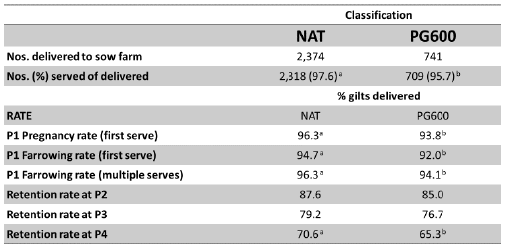
During this particular trial period, select gilts with a HNS record were moved to a down-stream sow farm every three weeks and 76% of the select gilts had shown natural, boar-induced, puberty, with the balance of gilts having a recorded HNS event in response to gonadotropin (PG 600) treatment (see Figure 4 for typical responses). The pre-breeding protocol stipulated that gilts were given at least 14 days of acclimation to stall housing before being bred at either their second of third heat. As can be seen in Table 1, the retention of these gilts within the breeding herd exceeds all benchmarks set by the industry, with relatively little difference in performance between natural- and PG600- induced estrus. However, it must be appreciated that these hormone-induced estrus events were triggered in gilts that had already been exposed to 23 days of boar primer pheromones, which has been shown to significantly increase the response of gilts to exogenous gonadotropins. As well as the excellent retention in the sow herd, these gilts produced over 55 total pigs born over their first four parities, which generally exceeds the average total lifetime production of the sows in many commercial herds.
The purpose of this first selection is to validate the use of proven puberty-induction programs to deliver gilts to the breeding herd with the potential for excellent SLP. The investment in good gilt management and rigorous gilt selection programs seems to largely remove many of the issues with SLP performance frequently identified as issues in the industry. In particular, these programs seem to largely remove problems with gilts that are on inventory but never produce a litter, and gilts that are culled before being rebred after wearing their first litter. In the next selection, we will try and provide evidence that these outcomes are largely due to the selection of the most sexually mature gilts available and proven links to later productive performance.
Age at puberty and lifetime performance
The literature supporting a link between early age at puberty and superior lifetime reproductive performance is extensive and has again been recently reviewed (Patterson and Foxcroft, 2019). For the last 25 years, successive studies have reported that gilts with an earlier onset of pubertal estrus have better overall fertility in terms of pigs produced and lifetime productivity. Additionally, all good managers know that the detection of standing estrus in the sow is the fundamental event that allows our breeding programs to succeed. Therefore, evidence that the “strength” of the behavioral traits at pubertal estrus are associated with the strength of estrus expression in the sow, suggests that a record of full standing heat at pubertal estrus should be an absolute requirement for gilts entering the breeding herd.
In terms of pubertal age per se, two questions are important. Firstly, what is the preferred age range that is linked to superior SLP. Secondly, having established this range, how can gilt selection programs be set up to identify these gilts. However, an even more fundamental question to address first is “what is the age of puberty in the gilt?” The answer to this question can only be answered by studying pubertal onset in gilts that are not subject to any constraints to their sexual maturation and then expose these gilts to potent boar stimuli from an early age. When this has been possible, it appears that the most precocious gilts probably show pubertal estrus as early as 130 days, with a fairly normal distribution in age at puberty thereafter. Interestingly, age at sexual maturation in the most precocious gilts has not changed for the last 50 years, and the two biggest variables that determine age at pubertal estrus in commercial production are the age at which puberty induction stimuli are provided, and the efficacy of this stimulation process. Fortunately, in a recent large scale study in commercial facilities, but using high health status gilts and daily exposure to a rotation of mature boars from 160 to 260 days of age, Calderon Diaz et al. (2016) provided outstanding data on which to base decisions about puberty induction programs. In an earlier review of these results, Valet (2015) provided evidence that three different sub-populations of gilts were represented in the overall response profile (Figure 3).
Figure 3. The response profile showing the percentage of gilts reaching pubertal estrus within successive 10-days periods in response to daily stimulation with mature boars from 160 to 260 days of age. Approaching 100% of gilts showed estrus within the 100-day period but distribution analysis identified and initial response profile involving the 85% of gilts that were recorded in pubertal estrus between 160 and 210 days of age. The remaining 15% of gilts seemed to be part of a different response population. From Valet, 2015.
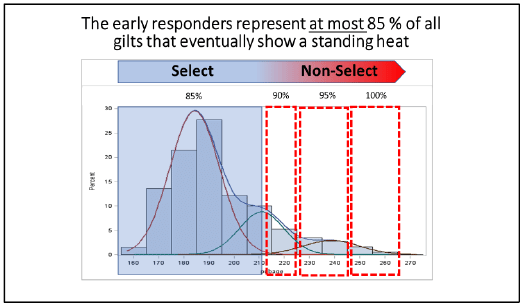
We can consider these response curves in the light of results from studies that link differences in either age at puberty or age at first service, to other measures of reproductive performance. The overall consensus from the published literature (see Patterson and Foxcroft, 2019) is that the gilts that have the least gilt non-productive days, the best retention in the breeding herd, and the best SLP, are those that either reach puberty at less than 200 days or are first bred at less than 230 days. In the latter case, assuming that a HNS program is in place to maximize first litter performance, this again determines that gilts need to be no more than 200-210 days at pubertal estrus. As seen in Figure 3, the population of gilts that are predicted to have superior reproductive performance are those that fall within the first response wave when boar stimulation was applied at 160 days. Therefore, restricting our definition of “select” gilts to those that show a pubertal heat by 200 days of age seems to identify those with the best potential reproductive performance.
Having made this determination, the next practical questions are: How limited can the selection program be and at what age should it be implemented? Assuming that the full complex of boar-derived stimuli is provided on a daily basis using mature and high libido boars, our experience is that boar stimulation from 170 days of age can identify most of the truly select gilts within a 30-day period (Figure 4). These response curves are derived from the same GDU/selection program shown in Figures 1 and 2. Across multiple cohorts of gilts flowing through the program, more than 75% of the gilts overall had a recorded HNS event by 200 days of age.
Figure 4. Puberty onset response curves for successive cohorts of pre-select gilts induced to reach pubertal estrus with daily boar stimulation from 170 days of age, with PG 600 treatment of nonpubertal gilts after 23 days of boar stimulation, as needed.
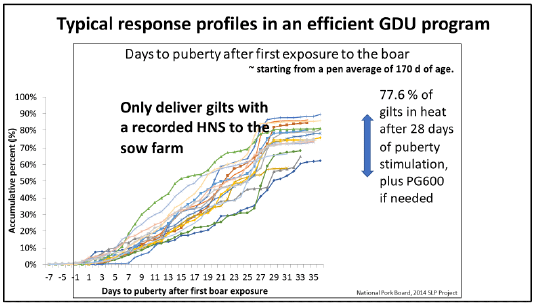
As seen in Figure 3, from the perspective of identifying the first early response group as being the preferred select population, any extension of the selection program beyond 200 days results in later maturing gilts falling in to the select population, with negative consequences for SLP. Starting the program later than 170 days but still ending at 200 days may allow most of the same gilts to express their true pubertal estrus, but optimal use of boar stimuli would be essential. However, if the length of the stimulation/selection window becomes less than 23 or 24 days, there is a possibility that previously pubertal gilts will not be observed in second estrus during the selection window and will be wrongly designated as non-select. Therefore, only taking account of the potential range of pubertal age in the gilt, the preferred selection window that allows discrimination between earlier and later responding gilts, and an adequate period of stimulation and recording to achieve at least an 80% response rate, seems to be 170 to 200 days of age. If less effective stimulation protocols are applied, an earlier start to the selection program, rather than an extension beyond 200 days is preferable.
Although retention of non-pubertal gilts within the gilt pool for more extended periods is common practice, and is justified on the basis of higher selection rates, on balance we suggest that this is a counterproductive approach and comes at a cost. Gilts that take longer to respond to boar exposure have longer entry to service intervals and accumulate excessive non-productive days. The management of these later maturing gilts also involves increasingly inefficient use of labor and space (measured as the number of gilts with a HNS record for each day in the selection program). Most importantly, these later maturing gilts have poorer reproductive efficiency over their productive life and are at risk of being over target weight and having poor retention in the breeding herd. Our preference, therefore, is to run the GDU as a strict all-in/all-out facility, and only allow gilts displaying a full standing heat within the designated selection window to move to the pre-breeding area.
Impacts of growth rate on gilt selection programs
The impressive growth performance of contemporary gilt populations has important implications for the pre-breeding management of gilts. In unselected gilt populations, or when feed restriction is limiting gilt growth and development, it has been possible to show that a threshold growth rate of around 0.55 kg/day exists, below which age at puberty in the gilt will increase. Two recent large-scale studies have confirmed that less than 10% of gilts fail to meet this growth threshold. Indeed, as shown in Figure 5, an increasing proportion of gilts have growth rates at the time of pubertal estrus that place them at risk of being too heavy if bred at second estrus. The scatter of data points in Figure 5 also shows that, as expected, growth rate is independent of age at puberty, and age has no predictive value for determining either age at pubertal estrus or gilt weight at a fixed age. Therefore, in gilt management programs it is essential that both these variables be recorded. Age at puberty (a HNS event at less than 200 days) is used to determine the relative sexual maturity and reproductive potential of the gilt: Weight at HNS is used to manage predicted weight at breeding.
Figure 5. Data from the study of Calderon Diaz et al. (2015) showing the relationship between lifetime average daily gain (ADG) to, and age at, pubertal estrus during a program of daily stimulation of high health status gilts with a rotation of mature boars. The dashed horizontal line indicates the threshold of ADG below which growth would be considered limiting for the expression of pubertal estrus. The solid near-horizontal line shows the fitted relationships between ADG and age at puberty, confirming that these are almost independent variables, with the extremes of growth rate having little overall effect on pubertal age. The extremes of ADG result in gilts with the same age at sexual maturation having a 40 kg difference in body weight. The vertical dashed lines indicate the window of gilt age at puberty that is most consistent with identifying the first wave of earlier responding gilts shown in Figure 3, whilst avoiding serious issues with gilts being too heavy at breeding at second estrus.
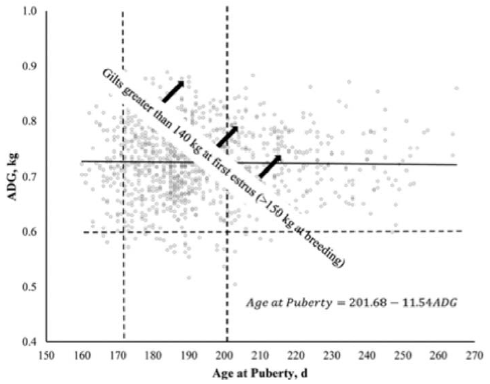
Considering again the optimal gilt selection window, we can see from Figure 5 that most gilts with a growth rate between 0.6 and 0.72 kg/day at the time of puberty could be bred at second estrus without exceeding an upper target breeding weight of 160 kg. However, gilts with the higher growth rates are at an increasing risk of being too heavy at breeding if they exhibit pubertal estrus on the later part of the selection window and are still management using a HNS strategy. One response to this risk of being overweight at breeding would be to designate the later responding but faster growing gilts to be bred at first, pubertal, estrus. However, this then prevents the producer from taking advantage of the important pre-breeding management protocols discussed below that maximize first litter performance and SLP. In the absence of technologies to limit growth performance in gilts, perhaps for poorer retention in the breeding herd. If nutritional approaches can be used to limit the growth performance of the faster growing gilts this would be an advantage. However, care should be taken to ensure that gilts are returned to a very positive metabolic state in the period preceding puberty stimulation and before breeding.
The main conclusion from this consideration of the impacts of growth rate on gilt management programs, is that exceeding 200 days as the cut-off for identifying select gilts has major consequences for weight at breeding. This second constraint leads us to again conclude that a selection window from 170 to 200 days of age is appropriate.
Pre-breeding management of gilts
Several different groups over the last 20 years have reported a clear relationship between either first or second litter size and SLP, of which Figure 6 is one example. These relationships seem to imply that high performing gilts become high performing sows, and vice versa. Although this fits well with the concept that early maturing gilts will also have better lifetime performance, the biology underlying the predictability of performance shown in Figure 6 is still unclear. Regardless of the mechanisms involved, these relationships suggest that optimizing first litter performance may have ongoing benefits in terms of SLP.
What factors contribute to good pre-breeding management in the gilt? Earlier studies demonstrated that maintaining a high level of feed intake between first and second estrus in the gilt was critical for increasing ovulation rate at second estrus and thus increasing potential litter size born. It seems from studies in more contemporary gilt populations that similar increases in ovulation rate between first and second estrus are not as critical. However, with ovulation rates of 18 in contemporary gilts compared to 14 or less in earlier studies, ovulation rate per se may be less of a constraint for first litter size than previously reported. In a more general sense, a number of production-based studies reported an improvement in litter size in gilts bred at second vs first estrus (see Patterson and Foxcroft, 2019). These trends have been confirmed in more recent analyses of production data and support the concept of building a HNS strategy into the final phase of the gilt development program.
Figure 6. Data demonstrating that first litter size is predictive of total born in later parities in commercial sow populations. From Pinilla et al. (2014).
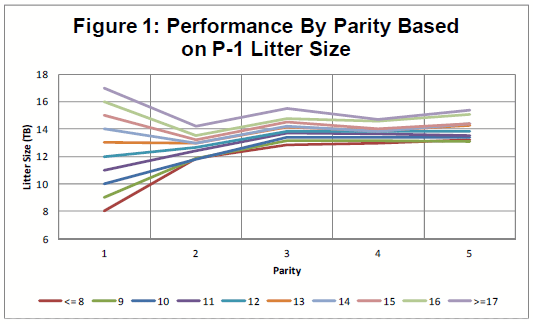
However, as earlier mechanistic studies reported an immediate and negative impact of reducing feed intake in pre-pubertal gilts on tonic LH secretion, it is important to recognize the sensitivity of the hypothalamic-pituitary-ovarian axis to a reduction in nutrient intake. These potential detrimental effects of reduced feed intake on the reproductive system during the critical period before breeding was part of the rationale for ensuring that replacement gilts have adequate time to properly acclimate to changes in location and housing before being bred. Although a recovery period of at least a week from “acclimation stress” was suggested, leading to a recommendation of 14 days of acclimation before breeding, more recent data suggest that nutritional regimens during the entire 21-day inter-estrus interval may have critical effects on first litter performance. Collectively, the information available suggests that implementation of a HNS program as a routine part of gilt management is important and allows producers to optimize first litter performance.
Measuring and managing critical components of gilt development
In their review of factors that affect the productivity of the breeding herd, Koketsu et al. (2017) stated that “Gilt development and management is critical to optimize the lifetime reproductive performance of sows. However, even though recording the age of gilts at first estrus and the dates of heat-no-serve can help improve gilt development and management, they are rarely recorded in commercial herds in North America”.
In comparison to the plethora of reproductive data that are routinely recorded for individual sows in the breeding herd, critical data on gilt development is definitely lacking and are not usually a component of the commonly used record analysis programs. As a consequence, the opportunity to objectively evaluate and monitor gilt development programs is lost: Yet good gilt performance is tacitly reported to be critical to future herd performance. Figure 6 identifies the key data that need to be collected to allow effective analysis and trouble-shooting of gilt development programs and shows how this links to the key objectives of a gilt development program. Once gilts receive a unique ID at the pre-selection stage (around 140 to 160 days in most systems) and enter the selection and pre-breeding program, daily records of performance are critical. These data should include estimated body weight at HNS and accumulated non-productive days (NPD) from entry into the herd data base until being successfully bred. It is interesting that the substantial cost of NPD accumulated by gilts that receive a herd ID but never produce a litter seems to be a minor concern to production managers, compared to say a marginal increase in the weaning-to-estrus interval in sows. However, both are indicators of important aspects of reproductive performance that need to be evaluated.
Figure 6. Key data that should be recorded as an integral part of gilt management programs.
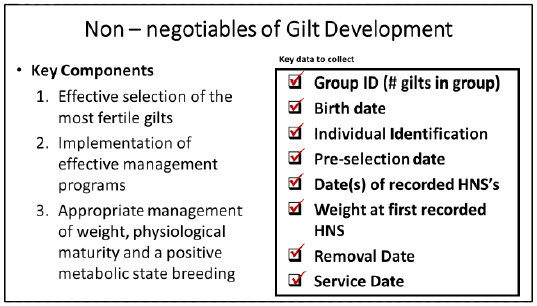
Data on gilt performance should not be captured in a vacuum, but should be used to provide weekly updates to production units on the performance of their GDUs relative to other GDUs in the production system. The analyses should also benchmark performance against the performance targets set for the gilt selection programs established. Key outcomes from these analyses could include: Response dynamics of successive cohorts of gilts to puberty-induction programs (as shown in Figure 4); Reports on the proportion of gilts completing a HNS protocol; Plots of the recorded inter-estrus interval (days between HNS and date of breeding); Data on weights at HNS and estimated weights at breeding. Each of these analyses can be used to confirm protocol compliance and to trouble-shoot issues that are affecting performance. Given that a successful gilt replacement program can become the foundation for excellent SLP, one could argue that more emphasis should be placed on the capture and analysis of a limited amount of gilt performance data than on the many metrics of sow performance that are routinely captured. One thing is certain, if the gilt program is badly managed, there will be many negative impacts on downstream sow performance that will need attention.
Conclusions
Establishing an effective gilt development and selection program takes commitment, the allocation of dedicated facilities, and committed staff time. There are no easy short cuts to an effective gilt selection program and this is definitely not “low hanging fruit”. However, the impact that well managed gilt development program can have on overall SLP is indisputable. Many of the ongoing issues with sow longevity in the breeding herd that use up valuable resources, but still prevent systems from meeting production targets, can be pre-empted by an effective program of gilt management. The proactive approach of committing resources to good gilt development seems to be a more predictable and less stressful option.
Published in the proceedings of the International Pig Veterinary Society Congress – IPVS2020. For information on the event, past and future editions, check out https://ipvs2022.com/en. 